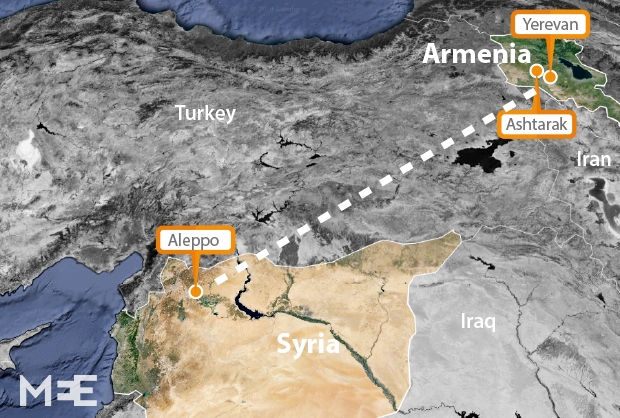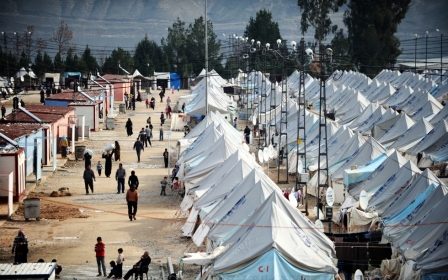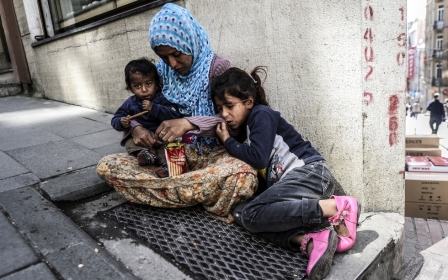‘New Aleppo’ rises in Armenia

Yerevan, ARMENIA - Back in the Syrian city of Aleppo, Harout was a successful man. He owned a clothing factory in the industrial district and a shop in an upscale neighbourhood. He lived in the centre of Aleppo’s Armenian area, surrounded by churches and street life, his family and the friends he grew up with.
Harout sighs with the heavy resignation of a man who has lost everything. “I’m 41 years old, I worked hard for 23 years,” he said. “But now my factory has emptied of everything - machines, everything. Until now I don't want to believe that I can’t return to Syria, but the reality is that maybe I need to find someplace better for my children’s futures.”
When he came to Yerevan, Armenia in the summer of 2012, he brought only his clothes with him. Harout thought he would be staying for a few weeks - until a sudden burst of violence in his home city had subsided. Two years later he is still here.
In the meantime, his factory has been ransacked, his friends and former workers scattered between government and rebel forces, and Aleppo has become the nightmarish epicentre of a war of endless attrition.
Around 10,000 Syrian-Armenians like Harout have sought refuge in Armenia since the civil war reached Aleppo. The flourishing Armenian community in Syria – and particularly in the country’s second city - was testament to the shelter that it offered to Armenians fleeing the Ottoman genocide in 1915.
Over three generations, Syria’s Armenians became famous as merchants and businessmen, the vital cogs in Aleppo’s great industrial machine - but they never lost their links back to Armenia.
“This is my homeland and I wanted to come here,” said Hagop, a former film director and actor who seemed to have few qualms about his new life as the owner of a clothes shop in Yerevan. “It was my dream for years to come back to Armenia as an Armenian.”
The Syrian-Armenians who have come to Yerevan know that fortune has been good to them – far better than to the hundreds of thousands of refugees who don’t have Armenian heritage and are living day to day in Syria’s bordering countries. They have been given the right to take Armenian passports, open businesses and use their Syrian driving licenses. Last year it was announced that a new town would be built with money donated by Armenian benefactors to give the families who had lost their homes in Syria the chance to buy a new property for a fraction of the market value. The town will be called New Aleppo.
“The idea came because of the high rental costs in Armenia,” said Lina Halajian, the president of the organisation that is overseeing the project together with the Armenian Ministry of Diaspora, and is herself an Aleppine who came to Armenia in 2012. “We asked for a $5,000 deposit from each, but in return they are going to get an apartment worth more than $50,000.”
The deal is an undeniable bargain: Lina said that 650 families expressed interest when the project was first launched.
But one year on, construction has still not started. At the site where New Aleppo is to be built – a patch of former industrial wasteland just outside the town of Ashtarak, 20km from Yerevan – there is nothing to suggest that this will be the place where a new community will grow. There are no signs, no hoardings and no excited future residents coming to take a look. Despite all the hype and initial interest around New Aleppo, something has gone wrong: donors don’t seem to want to give money for the project, and Syrians don't seem to want to live there. The project’s organisers are a long way off raising the $25m in donations that they need for the project, and not one single family has put down the money to reserve an apartment.
“I don’t know what they think,” said Halajian. “Maybe they have already rented a place out of their savings. Maybe $5,000 is a big amount. Or maybe they are thinking that the diaspora will contribute greatly and they will get it almost for free.”
Harout had a different explanation. “Why do they want to put us outside the capital?” he asked. “Why is it going to be built there? There are a lot of empty places in Yerevan. There’s nothing there in Ashtarak, it’s only a village. If I stayed in Armenia, I wouldn’t go to live there.”
On the streets of Ashtarak, the reasons for Harout’s dismissiveness are clear. The town had a tumbleweed quality even in the middle of a weekday afternoon.
“Everybody has been leaving Ashtarak in the past four years,” said Araya, an old man who was wandering past a half empty marketplace. “There are no industries or work here. Only 30 or 40 people in this town have a job.”
Another old man who overheard our conversation chipped in. “This is all bullshit!” he exclaimed. “The government is lying. If there is one building built for New Aleppo, you can come and spit on my forehead.”
His anger wasn’t directed towards the Syrians who would come to live here if New Aleppo should ever be built – in fact, many in Ashtarak said that they would be glad of the new life that the Syrians might bring to this slowly decaying town. The problem was that they saw the announcement of New Aleppo as merely a PR stunt by the Armenian government: they didn’t believe the town would ever actually be built.
“Whoever comes from Aleppo is coming straight to the airport and then leaving again,” said Araya. “They want to get a visa for Europe and then leave. In Armenia some people work for $200 a month, little money, just to survive.”
The difference between Ashtarak and Yerevan is striking. In the capital the streets are lined with designer boutiques – Armani, Gucci, and all the other names that mark out wealth in any modern city in the world. But here, too, the shops and the streets are noticeably empty. This facade of prosperity masks a deeply troubled economy, so while Armenia’s Ministry of Diaspora relentlessly urges Armenians who were born abroad to come back and live in their homeland, many of the people who are already here are desperate to leave again.
“I have decided that I will stay here, maximum, until Christmas,” said Harout. “Maximum six months, and then I will move to another place.” His new business in Yerevan, a fast food place that heaves with customers late into the night, is outwardly successful, but the turnover is a tenth that of his old business in Aleppo and the profit margins are far slimmer. He says that in Armenia, with its negligible reserves of raw materials, high import taxes and limited supply of skilled workers, it would be impossible for him to rebuild his old business.
A foreboding symbol of Armenia’s economic troubles overlooks the site that New Aleppo should have been built on – an abandoned factory embellished with modernist iconography but scarred by its smashed windows and the encroaching weeds on its forecourt. This used to be one of the main employers in Ashtarak, an electronics factory where over 1,500 people worked. It closed down in 1992.
Lina Harajian listened to the criticisms being levelled against the New Aleppo idea, and then dismissed them. “It’s a very nice project,” she said. “The location is perfect. There will be roughly 2,500 people living there, and a community of that size will open more opportunities for the city of Ashtarak.”
Despite the lack of money and interest, she insisted that New Aleppo will, one day, be built.
“The project is on standby for now, but it will happen – why not?”
New MEE newsletter: Jerusalem Dispatch
Sign up to get the latest insights and analysis on Israel-Palestine, alongside Turkey Unpacked and other MEE newsletters
Middle East Eye delivers independent and unrivalled coverage and analysis of the Middle East, North Africa and beyond. To learn more about republishing this content and the associated fees, please fill out this form. More about MEE can be found here.




